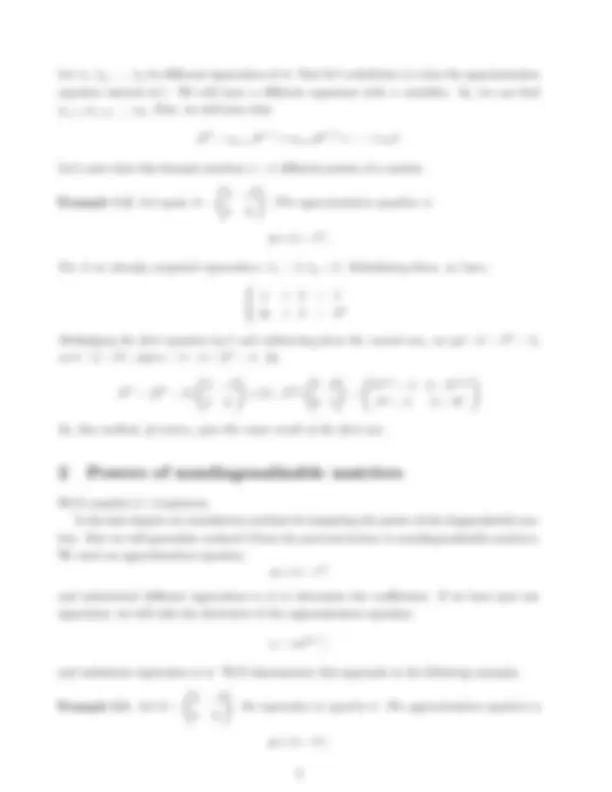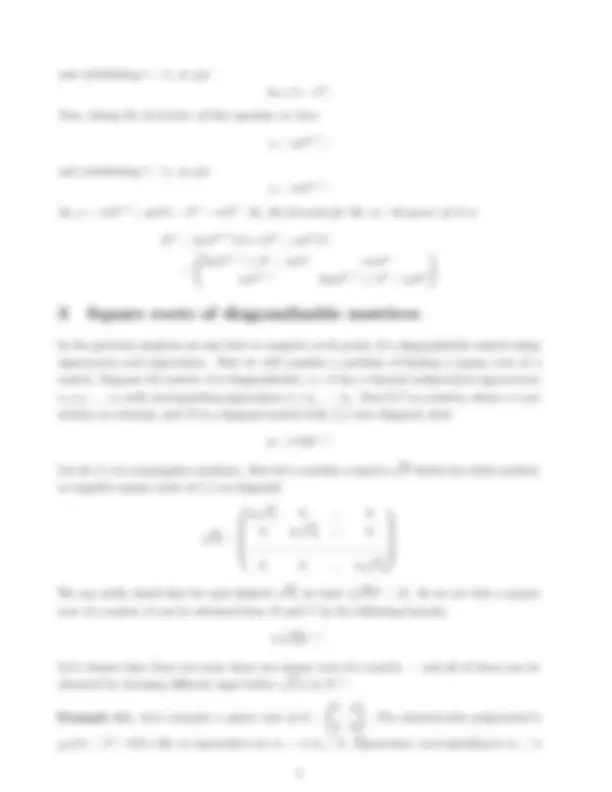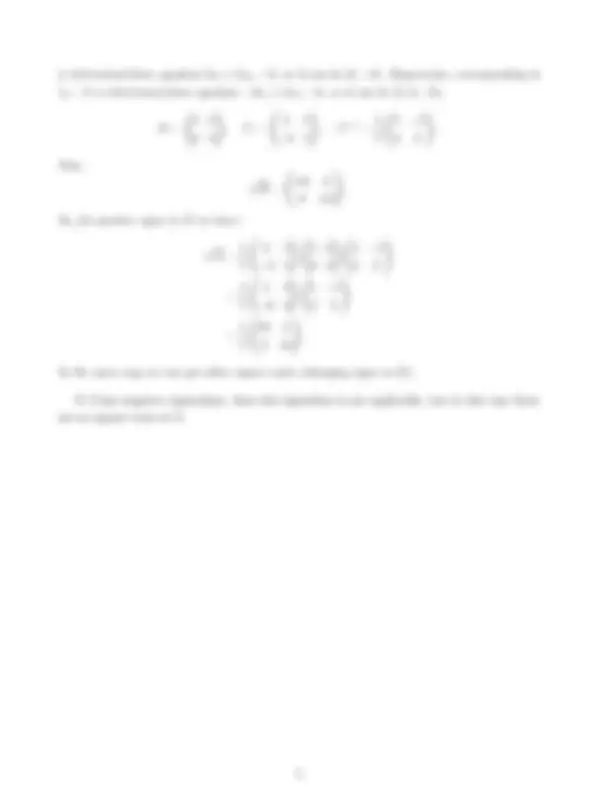





Study with the several resources on Docsity

Earn points by helping other students or get them with a premium plan


Prepare for your exams
Study with the several resources on Docsity

Earn points to download
Earn points by helping other students or get them with a premium plan
Community
Ask the community for help and clear up your study doubts
Discover the best universities in your country according to Docsity users
Free resources
Download our free guides on studying techniques, anxiety management strategies, and thesis advice from Docsity tutors
Two methods for computing the m-th power of a diagonalizable matrix using eigenvalues and eigenvectors. The first method involves diagonalization, while the second method uses an approximation equation. The document also covers finding the square root of a diagonalizable matrix.
Typology: Study notes
1 / 5

This page cannot be seen from the preview
Don't miss anything!




In this section we will give 2 algorithms of computing the m-th power of a matrix.
First method is based on diagonalization. Suppose A is a given matrix, and we want to find its m-th power, i.e. we want to get a formula for Am. We will suppose that the matrix A is diagonalizable. Let λ 1 , λ 2 ,... , λn be the eigenvalues of A, and e 1 , e 2 ,... , en be its linearly independent eigenvectors. Then we know, that there exists a matrix C, whose columns are eigenvectors, and a diagonal matrix
λ 1 0... 0 0 λ 2... 0
............... 0 0... λn
such that D = C−^1 AC, or A = CDC−^1.
Now we can see that
Am^ = (CDC−^1 )m = ( ︸CDC −^1 )(CDC︷︷− 1 ) · · · (CDC−^1 ︸) m = CD(C−^1 C)D(C−^1... C)DC−^1 = CDID... IDC−^1 = CDmC−^1.
But
Dm^ =
λ 1 0... 0 0 λ 2... 0
............... 0 0... λn
m
λm 1 0... 0 0 λm 2... 0
................. 0 0... λmn
So,
Am^ = C
λm 1 0... 0 0 λm 2... 0
................. 0 0... λmn
Example 1.1. Let’s find the formula for
)m
. The characteristic polynomial is
pA(λ) = λ^2 − 3 λ + 2.
So, the eigenvalues are λ 1 = 1, λ 2 = 2. Let’s compute eigenvectors.
λ 1 = 1. After subtraction λ 1 = 1 from the diagonal, we have
, so the eigenvector is (1, 1).
λ 2 = 2. After subtraction λ 2 = 2 from the diagonal, we have
, so the eigenvector is (2, 1).
Thus,
D =
Now we get
Am^ = CDmC−^1
=
)m ( − 1 2 1 − 1
0 2 m
1 2 m+ 1 2 m
−1 + 2m+1^2 − 2 m+ −1 + 2m^2 − 2 m
Let A be an n × n-matrix. Suppose it has n different eigenvalues. Then the algorithm goes as following. Let’s write the approximation equation:
an− 1 tn−^1 + an− 2 tn−^2 + · · · + a 1 = tm
and substituting t = 4, we get 4 a + b = 4m.
Now, taking the derivative of this equation we have
a = mtm−^1 ,
and substituting t = 4, we get a = m 4 m−^1.
So, a = m 4 m−^1 , and b = 4m^ − m 4 m. So, the formula for the m−-th power of A is
Am^ = (m 4 m−^1 )A + (4m^ − m 4 m)I
=
2 m 4 m−^1 + 4m^ − m 4 m^ −m 4 m m 4 m−^1 6 m 4 m−^1 + 4m^ − m 4 m
3 Square roots of diagonalizable matrices
In the previous chapters we saw how to compute m-th power of a diagonalizable matrix using eigenvectors and eigenvalues. Now we will consider a problem of finding a square root of a matrix. Suppose the matrix A is diagonalizable, i.e. it has n linearly independent eigenvectors e 1 , e 2 ,... , en with corresponding eigenvalues λ 1 , λ 2 ,... , λn. Now if C is a matrix, where ei’s are written as columns, and D is a diagonal matrix with λi’s over diagonal, then
A = CDC−^1.
Let all λi’s be nonnegative numbers. Now let’s consider a matrix
D which has either positive or negative square roots of λi’s on diagonal:
λ 1 0... 0 0 ±
λ 2... 0
.......................... 0 0... ±
λn
We can easily check that for such defined
D, we have (
D)^2 = D. So we see that a square root of a matrix A can be obtained from D and C by the following formula:
C
Let’s denote that there are more than one square root of a matrix — and all of them can be obtained by choosing different signs before
λi’s in D−^1.
Example 3.1. Let’s compute a square root of A =
. The characteristic polynomial is
pA(λ) = λ^2 − 13 λ + 36, so eigenvalues are λ 1 = 4, λ 2 = 9. Eigenvector, corresponding to λ 1 = 4
is determined from equation 3 x 1 + 2x 2 = 0, so it can be (2, −3). Eigenvector, corresponding to λ 2 = 9 is determined from equation − 2 x 1 + 2x 2 = 0, so it can be (1, 1). So,
Now, √ D =
So, for positive signs in D we have:
√ A =^15
In the same way we can get other square roots (changing signs in D).
If A has negative eigenvalues, then this algorithm is not applicable, but in this case there are no square roots of A.